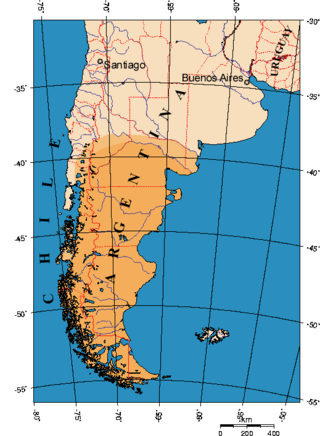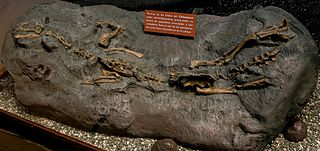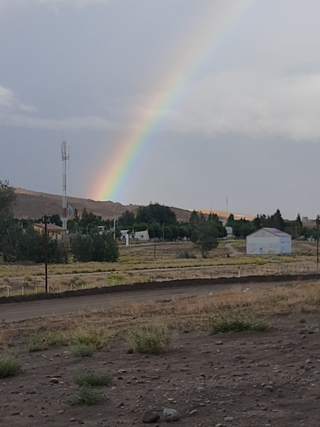
Patagonia is a geographical region that encompasses the southern end of South America, governed by Argentina and Chile. The region comprises the southern section of the Andes Mountains with lakes, fjords, temperate rainforests, and glaciers in the west and deserts, tablelands and steppes to the east. Patagonia is bounded by the Pacific Ocean on the west, the Atlantic Ocean to the east, and many bodies of water that connect them, such as the Strait of Magellan, the Beagle Channel, and the Drake Passage to the south.

Chubut is a province in southern Argentina, situated between the 42nd parallel south, the 46th parallel south, the Andes range to the west, and the Atlantic ocean to the east. The province's name derives from the Tehuelche word chupat, meaning "transparent," their description of the Chubut River.

General Carrera Lake or Lake Buenos Aires is a deep lake located in Patagonia and shared by Argentina and Chile. Both names are internationally accepted, while the autochthonous name of the lake is Chelenko, which means "stormy waters" in Aonikenk. Another historical name is Coluguape from Mapuche, a derivative of this name is applied to Colhué Huapí Lake after Argentine explorer Francisco Moreno reached this lake in 1876 conflating it with Coluguape.
The Magallanes Basin or Austral Basin is a major sedimentary basin in southern Patagonia. The basin covers a surface of about 170,000 to 200,000 square kilometres and has a NNW-SSE oriented shape. The basin is bounded to the west by the Andes mountains and is separated from the Malvinas Basin to the east by the Río Chico-Dungeness High. The basin evolved from being an extensional back-arc basin in the Mesozoic to being a compressional foreland basin in the Cenozoic. Rocks within the basin are Jurassic in age and include the Cerro Toro Formation. Three ages of the SALMA classification are defined in the basin; the Early Miocene Santacrucian from the Santa Cruz Formation and Friasian from the Río Frías Formation and the Pleistocene Ensenadan from the La Ensenada Formation.
The Cerro Barcino Formation is a geological formation in South America whose strata span the Early Cretaceous to the earliest Late Cretaceous. The top age for the formation has been estimated to be Cenomanian. Earlier estimates placed the formation until the Campanian.
The Divisaderan age is a South American land mammal age, covering a period of geologic time within the Middle and Late Eocene epochs of the Paleogene. It follows the Mustersan age and is followed by the Tinguirirican age.
The Tinguirirican age is a period of geologic time within the Late Eocene and Early Oligocene epochs of the Paleogene, used more specifically within the SALMA classification in South America. It follows the Divisaderan and precedes the Deseadan age.

The Cañadón Asfalto Formation is a geological formation from the Lower to Middle Jurassic. The Cañadón Asfalto Formation is located in the Cañadón Asfalto Basin, a rift basin in the Chubut Province of northwestern Patagonia, southern Argentina. The basin started forming in the earliest Jurassic.

The Coihaique Group is a group of geological formations in northwestern Patagonia. From top to bottom the formations that make the group are Apeleg, Katterfeld and Toqui. The contact between the formations of the group are diachronous with Katterfeld Formation interfingering with the formations on top and below it. The lower and upper boundaries of the group are unconformities formed by erosion. The older parts of Coihaique Group represent a marine transgression while the younger parts evidences a return to non-marine conditions.

The Golfo San Jorge Basin is a hydrocarbon-rich sedimentary basin located in eastern Patagonia, Argentina. The basin covers the entire San Jorge Gulf and an inland area west of it, having one half located in Santa Cruz Province and the other in Chubut Province. The northern boundary of the basin is the North Patagonian Massif while the Deseado Massif forms the southern boundary of the basin. The basin has largely developed under condition of extensional tectonics, including rifting.
Tobífera Formation is a volcano-sedimentary formation of Middle to Late Jurassic age. The formation is crops out in the Magallanes Region in southern Patagonia and Tierra del Fuego of Chile, the Santa Cruz Province of southern Argentina, and in the subsurface of the Malvinas Basin offshore Argentina and the Falkland Islands.
Traiguén Formation is a volcano-sedimentary formation of Miocene age, located in the archipelagoes of Aysén Region of western Patagonia.

The Cañadón Calcáreo Formation is an Oxfordian to Kimmeridgian-aged geologic formation, from the Cañadón Asfalto Basin in Chubut Province, Argentina, a rift basin that started forming since the earliest Jurassic. It was formerly thought to date into the Cretaceous, but the age has been revised with Uranium–lead dating as likely being solely Late Jurassic in age.
La Cascada Formation a sedimentary formation near Futaleufú in the western Patagonian Andes of southern Chile. Lithologies vary from sandstone, siltstone and conglomerate. The sediment that now forms the rock deposited during the Oligocene and Early Miocene epoch in shallow marine environment. The formation contain fossils of bivalves and gastropods.
Río Frías Formation is a Middle Miocene geologic formation made up sedimentary rock located in Aysén Region, western Patagonia. The formation crops out along the upper couse of Cisnes River. Marsupial fossils have been found in the formation. The Friasian period in the South American Land Mammal Ages is named after the formation.

The Collón Curá Formation is a Middle Miocene fossiliferous geological formation of the southern Neuquén Basin in northwestern Patagonia and the western Cañadón Asfalto Basin of central Patagonia, Argentina. The formation crops out from the southern Neuquén Province, the western Río Negro Province to the northern Chubut Province.
The Cañadón Asfalto Basin is an irregularly shaped sedimentary basin located in north-central Patagonia, Argentina. The basin stretches from and partly covers the North Patagonian Massif in the north, a high forming the boundary of the basin with the Neuquén Basin in the northwest, to the Cotricó High in the south, separating the basin from the Golfo San Jorge Basin. It is located in the southern part of Río Negro Province and northern part of Chubut Province. The eastern boundary of the basin is the North Patagonian Massif separating it from the offshore Valdés Basin and it is bound in the west by the Patagonian Andes, separating it from the small Ñirihuau Basin.

The Gaiman Formation, in older literature also referred to as Patagonian Marine Formation, is a fossiliferous geologic formation of the Peninsula Valdés Basin in the eastern Chubut Province of northwestern Patagonia, eastern Argentina.
Los Adobes Formation is an Early Cretaceous (Aptian) geologic formation in Chubut Province, in the Cañadón Asfalto Basin of central Patagonia, Argentina. The formation belongs to the Chubut Group and represents the Early Cretaceous K1 megasequence in the basin, unconformably overlying the Late Jurassic Cañadón Calcáreo Formation and is overlain by the Albian Cerro Barcino Formation.
The Agua de la Piedra Formation is a Late Oligocene geologic formation of the Malargüe Group that crops out in the southernmost Precordillera and northernmost Neuquén Basin in southern Mendoza Province, Argentina.







